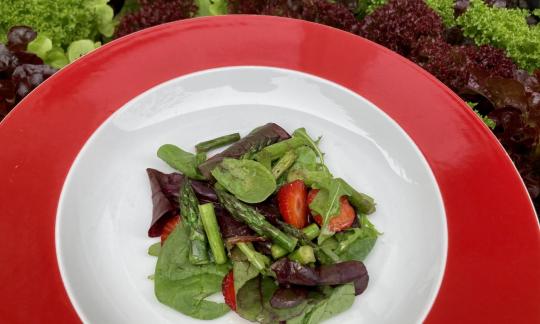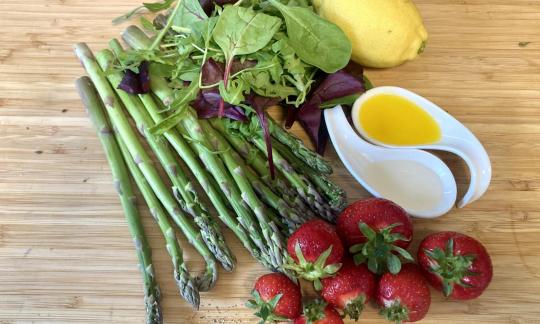Quick fruity salad with green asparagus and strawberries
raw-vegan
Ingredients (for servings, )
| For the salad | |
|---|---|
| 18 oz | Asparagus, raw (organic?) |
| ¼ tsp | Rapeseed oil, refined (organic?) (0.04 oz) |
| 2 ⅛ oz | Lamb's lettuce, raw (organic?) |
| 8 ½ oz | Strawberries (organic?) |
| For the dressing | |
| ½ | Lemons, raw (limes, organic?) (1.0 oz) |
| 1 tbsp | Rapeseed oil (canola, HOLL oil, kernel oil), cold pressed?, organic? (0.49 oz) |
| 1 dash | Table salt (table salt, raw?, organic?) (0.01 oz) |
| 1 dash | Black pepper (organic?, raw?) (0.00 oz) |
Equipment
- vegetable peeler
- skillet (frying pan)
- stove
- citrus juicer (lemon squeezer)
- salad spinner
Type of preparation
- cook
- fry
- chop or grind
- squeeze
- season to taste
- peel
- drain
Preparation
For the salad
Wash the asparagus, cut off the ends and peel the lower parts if necessary.
Heat some rapeseed oil in the pan and fry the asparagus with a little salt for about 5 minutes. Stir frequently. Then set aside and continue with the next step.If you prefer very fresh, thin green asparagus, you only need to cut off the ends. If the asparagus is older, you may need to peel the lower ends.
Wash the lettuce and spin dry. Clean the strawberries and cut them into slices.
Preferably use smaller, sweet and aromatic strawberries. These give the salad its decisive aroma.
Choice of salad: We used leaf lettuce. However, you can also use other fine lettuce, such as iceberg lettuce orbutterhead lettuce. The lettuce should be tender and not too intense.
For the dressing
Squeeze the lemon and mix only half of the juice with cold-pressed rapeseed oil, salt and pepper and optionally white balsamic vinegar. The amount of lemon juice depends on the sweetness of the strawberries. It is therefore advisable not to add all the juice at first.Balsamic vinegar and raw food: If you use balsamic vinegar, the dish is strictly speaking no longer raw vegan, which is why we have only listed this ingredient as optional.
Finishing the salad
Place the asparagus in a bowl and mix with the dressing. Season with salt, pepper, optional balsamic vinegar and lemon juice and serve.
|
Nutritional Information per person
Convert per 100g
|
2000 kcal | |
|---|---|---|
| Energy | 168 kcal | 8.4% |
| Fat/Lipids | 8.4 g | 12.0% |
| Saturated Fats | 0.68 g | 3.4% |
| Carbohydrates (inc.dietary fiber) | 22 g | 8.1% |
| Sugars | 11 g | 12.4% |
| Fiber | 8.2 g | 32.7% |
| Protein/Albumin | 7.1 g | 14.2% |
| Cooking Salt (Na:85.3 mg) | 217 mg | 9.0% |
| Essential micronutrients with the highest proportions | per person | 2000 kcal | |
|---|---|---|---|
| Vit | Vitamin K | 112 µg | 150.0% |
| Vit | Vitamin C (ascorbic acid) | 107 mg | 133.0% |
| Vit | Vitamin B9, B11 (Folate, as the active form of folic acid) | 166 µg | 83.0% |
| Min | Copper, Cu | 0.58 mg | 58.0% |
| Min | Manganese, Mn | 1.00 mg | 50.0% |
| Min | Iron, Fe | 6.6 mg | 47.0% |
| Elem | Potassium, K | 855 mg | 43.0% |
| Fat | Alpha-Linolenic acid; ALA; 18:3 omega-3 | 0.80 g | 40.0% |
| Vit | Vitamin B1 (Thiamine) | 0.42 mg | 38.0% |
| Vit | Vitamin E, as a-TEs | 4.6 mg | 38.0% |
Detailed Nutritional Information per Person for this Recipe
The majority of the nutritional information comes from the USDA (US Department of Agriculture). This means that the information for natural products is often incomplete or only given within broader categories, whereas in most cases products made from these have more complete information displayed.
If we take flaxseed, for example, the important essential amino acid ALA (omega-3) is only included in an overarching category whereas for flaxseed oil ALA is listed specifically. In time, we will be able to change this, but it will require a lot of work. An “i” appears behind ingredients that have been adjusted and an explanation appears when you hover over this symbol.
For Erb Muesli, the original calculations resulted in 48 % of the daily requirement of ALA — but with the correction, we see that the muesli actually covers >100 % of the necessary recommendation for the omega-3 fatty acid ALA. Our goal is to eventually be able to compare the nutritional value of our recipes with those that are used in conventional western lifestyles.
| Essential fatty acids | per person | 2000 kcal |
|---|---|---|
| Alpha-Linolenic acid; ALA; 18:3 omega-3 | 0.80 g | 40.0% |
| Linoleic acid; LA; 18:2 omega-6 | 1.6 g | 16.0% |
| Essential amino acids | per person | 2000 kcal |
|---|---|---|
| Tryptophan (Trp, W) | 0.08 g | 34.0% |
| Threonine (Thr, T, irreversibly transaminated) | 0.26 g | 28.0% |
| Valin (Val, V) | 0.34 g | 21.0% |
| Isoleucine (Ile, I) | 0.24 g | 19.0% |
| Leucine (Leu, L) | 0.40 g | 17.0% |
| Lysine (Lys, K, irreversibly transaminated) | 0.32 g | 17.0% |
| Phenylalanine (Phe, F) | 0.24 g | 15.0% |
| Methionine (Met, M) | 0.09 g | 9.0% |
| Vitamins | per person | 2000 kcal |
|---|---|---|
| Vitamin K | 112 µg | 150.0% |
| Vitamin C (ascorbic acid) | 107 mg | 133.0% |
| Vitamin B9, B11 (Folate, as the active form of folic acid) | 166 µg | 83.0% |
| Vitamin B1 (Thiamine) | 0.42 mg | 38.0% |
| Vitamin E, as a-TEs | 4.6 mg | 38.0% |
| Vitamin A, as RAE | 246 µg | 31.0% |
| Vitamin B2 (Riboflavin) | 0.41 mg | 29.0% |
| Vitamin B6 (pyridoxine) | 0.38 mg | 27.0% |
| Vitamin B7 (Biotin, ex vitamin H) | 10 µg | 20.0% |
| Vitamin B3 (Niacin) | 3.1 mg | 19.0% |
| Vitamin B5 (Pantothenic acid) | 0.88 mg | 15.0% |
| Essential macroelements (macronutrients) | per person | 2000 kcal |
|---|---|---|
| Potassium, K | 855 mg | 43.0% |
| Phosphorus, P | 178 mg | 25.0% |
| Magnesium, Mg | 56 mg | 15.0% |
| Calcium, Ca | 95 mg | 12.0% |
| Sodium, Na | 85 mg | 11.0% |
| Essential trace elements (micronutrients) | per person | 2000 kcal |
|---|---|---|
| Copper, Cu | 0.58 mg | 58.0% |
| Manganese, Mn | 1.00 mg | 50.0% |
| Iron, Fe | 6.6 mg | 47.0% |
| Zinc, Zn | 1.7 mg | 17.0% |
| Iod, I (Jod, J) | 21 µg | 14.0% |
| Selenium, Se | 6.6 µg | 12.0% |
| Fluorine, F | 5.5 µg | < 0.1% |
This quick salad with green asparagus and strawberries is summery, light and wonderfully fruity.
Nutrient profile: According to GDA guidelines, one portion of this dish covers twice the average daily requirement of vitamin K. Vitamin C is covered by over 100% and folic acid by almost 90%. The ratio of omega-6 to omega-3 fatty acids is 2:1, well below the maximum recommended ratio of 5:1.
You can find further information on this topic at the following link: Vegans often eat unhealthily. Avoidable nutritional errors.
Portion information: The specified amount for 2 people is sufficient for a light main course for 2 or a starter or side dish for 4 people.
Asparagus: Asparagus contains, among other things, the protein building block asparagine, which gave asparagus its name. L-aspartic acid is responsible for its dehydrating effect, promotes kidney function and stimulates water excretion. For this reason, asparagus is used in traditional medicine for bladder infections. In addition to the white asparagus that is preferred here, there are also purple and green asparagus, which have a more intense flavor. The time of harvest is crucial for the color of the asparagus: while white asparagus grows under the ground in mounds of earth, protected from the sun, purple asparagus is harvested as soon as it has broken through the surface of the earth. Green asparagus grows mostly above ground. Purple and especially green asparagus contain more vitamins and healthy secondary plant substances than white asparagus.
Strawberries: Strawberries have a high vitamin C content. Unlike apples and kiwis, strawberries do not ripen if picked too early (non-climacteric fruit). Therefore, you should pay attention to the color and scent when buying.
Olive oil versus rapeseed oil: Economic forces and lobbying have made olive oil a cult oil, although the omega-6 (LA) to omega-3 fatty acid (ALA) ratio is significantly higher than the recommended maximum ratio of 5:1. Compared to olive oil, rapeseed oil has several times the proportion of essential fatty acids, especially omega-3 fatty acids. However, only refined rapeseed oil is suitable for cooking and frying, which is why we use this in the corresponding preparation step and only use cold-pressed rapeseed oil for the dressing.
The quality of the products plays a role in this recipe. If you prefer, use very fresh, thin green asparagus; you only need to cut off the ends. If you use older asparagus, you may need to peel the lower ends. If possible, use smaller, sweet and aromatic strawberries. These give the salad its decisive aroma. We used leaf lettuce. However, any other tender lettuce is also suitable, such as oak leaf lettuce, lamb's lettuce or a mixture.
Asparagus season: The local asparagus season for white asparagus in Europe lasts from mid-April to traditionally June 24th.
Balsamic vinegar: If you use balsamic vinegar, the dish is strictly speaking no longer raw vegan, which is why we have only listed this ingredient as optional.
Choice of salad: We used leaf lettuce. However, you can also use other fine lettuce, such as iceberg lettuce orbutterhead lettuce. The lettuce should be tender and not too intense.
Asparagus: You can use purple or white asparagus instead of green asparagus. However, you must peel it completely first. You also need to extend the preparation time a little so that the asparagus still has a good bite but is no longer completely raw. You can also serve the salad with slightly lukewarm asparagus or cold.






